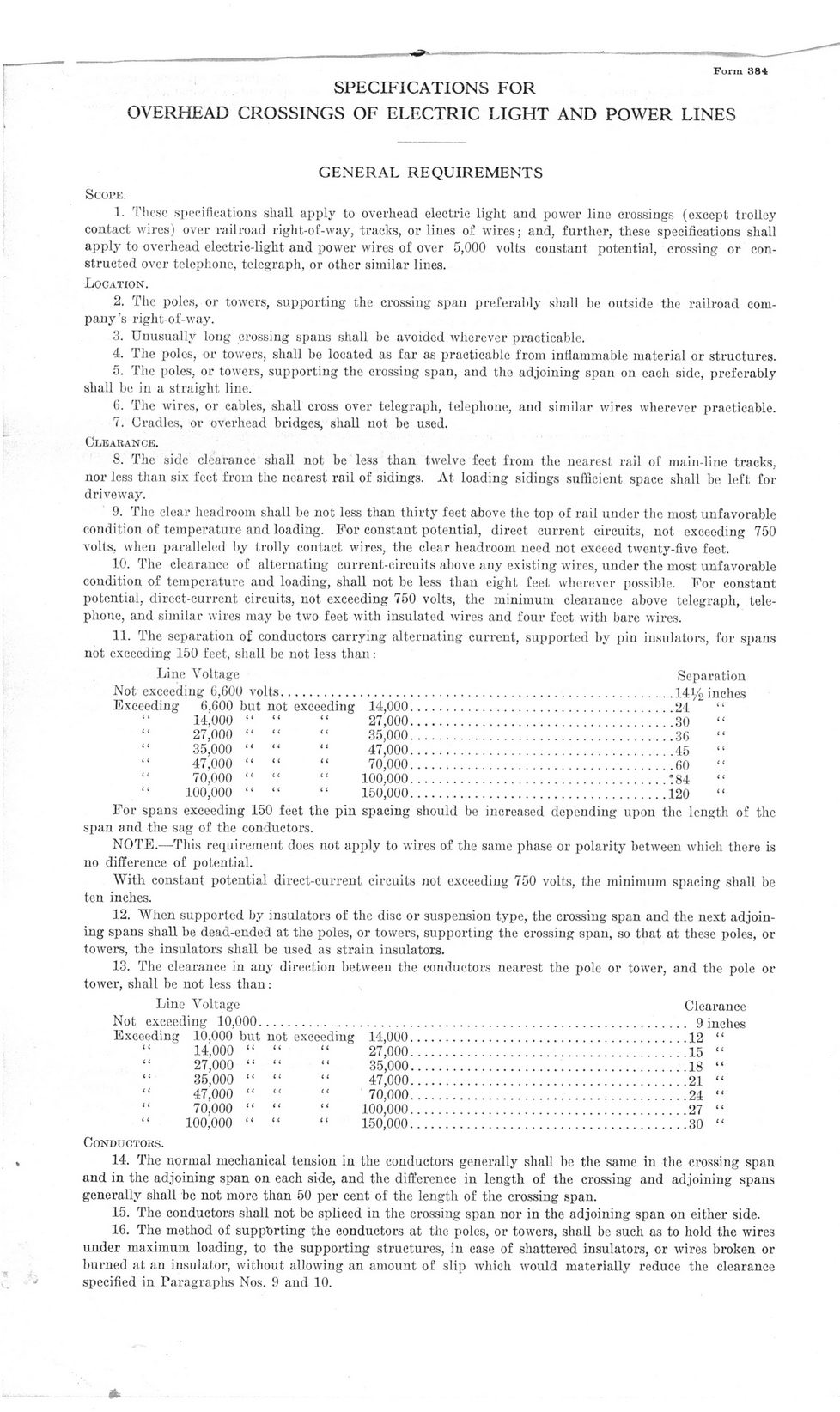This text was obtained via automated optical character recognition.
It has not been edited and may therefore contain several errors.
Form 384 SPECIFICATIONS FOR OVERHEAD CROSSINGS OF ELECTRIC LIGHT AND POWER LINES GENERAL REQUIREMENTS Scope. 1. These specifications shall apply to overhead electric light and power line crossings (except trolley contact wires) over railroad right-of-way, tracks, or lines of wires; and, further, these specifications shall apply to overhead electric-liglit and power wires of over 5,000 volts constant potential, crossing or constructed over telephone, telegraph, or other similar lines. Location. 2. The poles, or towers, supporting the crossing span preferably shall be outside the railroad company ?s right-of-way. 3. Unusually long crossing spans shall be avoided wherever practicable. 4. The poles, or towers, shall be located as far as practicable from inflammable material or structures. 5. The poles, or towers, supporting the crossing span, and the adjoining span on each side, preferably shall be in a straight line. (). The wires, or cables, shall cross over telegraph, telephone, and similar wires wherever practicable. 7. Cradles, or overhead bridges, shall not be used. Clearance. 8. The side clearance shall not be less than twelve feet from the nearest rail of main-line tracks, nor less than six feet from the nearest rail of sidings. At loading sidings sufficient space shall be left for driveway. 9. The clear headroom shall be not less than thirty feet above the top of rail under the most unfavorable condition of temperature and loading. For constant potential, direct current circuits, not exceeding 750 volts, when paralleled by trolly contact wires, the clear headroom need not exceed twenty-five feet. 10. The clearance of alternating current-circuits above any existing wires, under the most unfavorable condition of temperature and loading, shall not be less than eight feet wherever possible. For constant potential, direct-current circuits, not exceeding 750 volts, the minimum clearance above telegraph, telephone, and similar wii'es may be two feet with insulated wires and four feet with bare wires. 11. The separation of conductors carrying alternating current, supported by pin insulators, for spans not exceeding 150 feet, shall be not less than: Line Voltage Separation Not exceeding 6,600 volts........................................................................14% inches Exceeding 6,600 but not exceeding 14,000.........................................................24 ? 14.000 ? ? ? 27,000.....................................................30 27.000 ? ? ? 35,000.....................................................36 35.000 ? ? ? 47,000.....................................................45 47.000 ? ? ? 70,000.....................................................60 70.000 ? ? ? 100,000....................................................!84 100,000 ? ? ? 150,000....................................................120 For spans exceeding 150 feet the pin spacing should be increased depending upon the length of the span and the sag of the conductors. NOTE.?This requirement does not apply to wires of the same phase or polarity between which there is no difference of potential. With constant potential direct-current circuits not exceeding 750 volts, the minimum spacing shall be ten inches. 12. When supported by insulators of the disc or suspension type, the crossing span and the next adjoining spans shall be dead-ended at the poles, or towers, supporting the crossing span, so that at these poles, or towers, the insulators shall be used as strain insulators. 13. The clearance in any direction between the conductors nearest the pole or tower, and the pole or tower, shall be not less than: Line Voltage Clearance Not exceeding 10,000................................................................................ 9 inches Exceeding 10,000 but not exceeding 14,000.....................................................12 ? 14.000 ? ? ? 27,000.................................................15 ? 27.000 ? ? ? 35,000.................................................18 ? 35.000 ? ? ? 47,000.................................................21 ? 47.000 ? ? ? 70,000.................................................24 ? 70.000 ? ? ? 100,000.................................................27 ? 100,000 ? ? ? 150,000.................................................30 ? Conductors. 14. The normal mechanical tension in the conductors generally shall be the same in the crossing span and in the adjoining span on each side, and the difference in length of the crossing and adjoining spans generally shall be not more than 50 per cent of the length of the crossing span. 15. The conductors shall not be spliced in the crossing span nor in the adjoining span on either side. 16. The method of supporting the conductors at the poles, or towers, shall be such as to hold the wires under maximum loading, to the supporting structures, in case of shattered insulators, or wires broken or burned at an insulator, without allowing an amount of slip which would materially reduce the clearance specified in Paragraphs Nos. 9 and 10.

Gainesville R.R L&n-Railroad-and-Ice-Light-and-Bottling-Works-Contract-(1921)-2